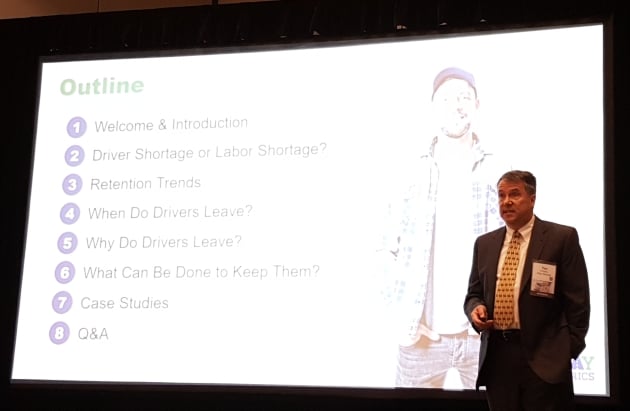Put me in, coach
HOUSTON, Texas – Change is inevitable, and as a professional, if you approach it like Oakland A’s executive Billy Beane, you will find success.
That’s according to Laura Long, project manager, professional services for Trimble Transportation Mobility, who showed a clip of the movie Moneyball to highlight how to manage change in the workplace. In the movie – which is based on a true story – there is significant change happening within the A’s organization by building an entire new way to manage the baseball team. The way Beane handles the change is the way Long believes everyone should approach the challenge.
“Change your game,” said Long. “We all know none of this is easy, especially in our industry.”
Long’s presentation during the PeopleNet in.sight User Conference in Houston Sept. 11 focused on how carriers can make the change to ELDs a smooth process, one that has already begun in the U.S. with last year’s mandate and soon to occur in Canada when it follows suit.
Long addressed operational change management, specifically the ADKAR method for implementing change – awareness, desire, knowledge, ability, and reinforcement.
With regards to awareness, those going through the change need to ask themselves why they have to make the changes being asked of them. For ELDs, there is the mandate, which requires carriers to make the change, and the benefits ELDs provide.
Desire poses the question, why would I want to do things differently. Do you want to continue your career as a professional driver? Look at the ways an ELD can help you do your job, and do you have any thoughts on how to better use the device?
Whenever a change is made in a company, training is a must to ensure all staff has the knowledge necessary to be successful.
Ability addresses how staff will perform their tasks differently after the change. Training, assistance, and being made aware of the change prior to its implementation are vital.
“As we go along the peaks of the mountain, we require more and more coaching,” said Long of the process.
Finally, ongoing reinforcement will make sure the change continues to be utilized. Drivers must receive daily, weekly, and monthly assessments to establish accountability.
“Most fleet managers can identify the drivers who are going to need that extra help,” said Long, adding that it can often be employees who have been with the company the longest who are most reluctant to the change, and can be transformed into leaders in the effort.
Retaining drivers
Recognizing, rewarding, and listening to your drivers is the best way to keep them from walking out the door.
Tim Hindes, co-founder and CEO of Stay Metrics, is a big believer in this mantra, saying it could make a significant difference in a carrier’s driver retention efforts.
“Reward your drivers more than you ever did in the past,” said Hindes, adding that the driver shortage is indeed a real issue and not one that has been exaggerated in the media. “We’re not getting kids picked up from school, we’re not getting loads picked up. It’s real.”

In a time when drivers are so difficult to come by, retaining drivers is all that much more important.
Hindes showed research from the American Transport Research Institute that in 1994, the largest age demographic for drivers as between 20-34 at 39.6% and the smallest was over 55 at 11%. In 2003, the largest group was between the ages of 35-44, the smallest still over 55. However, by the year 2013, the largest age group for drivers was aged 45-54 at 29.3%, and the smallest group had shifted to those aged 20-34. Drivers over the age of 55 jumped to 26.2%.
Another trend Hindes underscored was that 57% of drivers leave a company within the first six months.
Some of the predictors of why a driver leaves were that orientation did not prepare them for the reality of the job, a lack of respect from the carrier, the recruiter misled the driver about the job duties, and compensation was not what the driver expected.
“Pay is not a predictor of turnover for drivers…that was true up until about a year ago,” said Hindes. “We’re starting to see some carriers move the needle on the rate of pay and pay some bonuses.”
In order to keep new drivers, carriers must align their recruiter’s message with the actual experience working for the company.
Conducting regular driver surveys has also shown to help retain drivers, according to Hindes.
Surveys should be done regularly, with a larger 125-word version conducted every year. Exit surveys are also important, but should be done by a third party to ensure honesty.
Have your say
This is a moderated forum. Comments will no longer be published unless they are accompanied by a first and last name and a verifiable email address. (Today's Trucking will not publish or share the email address.) Profane language and content deemed to be libelous, racist, or threatening in nature will not be published under any circumstances.